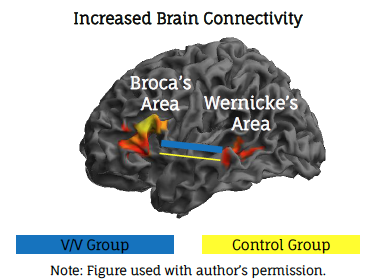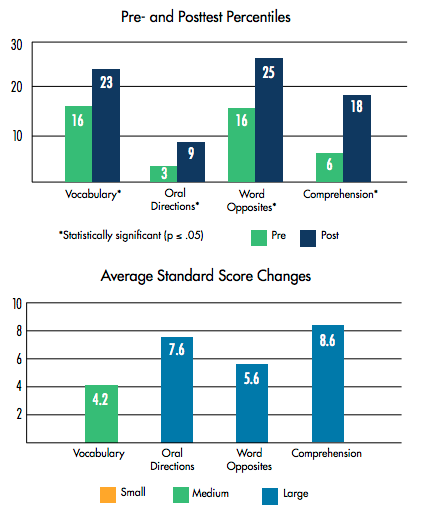
Lindamood-Bell has been involved with research for over 30 years. We actively take part in peer-reviewed studies of our programs and instruction and monitor student results at our learning centers and school partnerships to ensure we maintain our exceptional standard of quality. We have partnered with such institutions as the University of Alabama, MIT, and Wake Forest University to conduct neurological and behavioral research.
The research consistently proves that Lindamood-Bell instruction changes the brain functions underlying language and literacy skills. These brain functions continue to improve after our instruction has ended.
We believe all individuals can be taught to read to their potential—including those who have a previous diagnosis of autism spectrum disorder (ASD).
Numerous studies examining the effectiveness of our instruction with students with autism have been conducted; we have summarized and included links to several below.
Visit our Research & Development site for more information, studies, and references.
Summary of Behavioral & Neurological Research—Autism
Changes in Intrinsic Connectivity of the Brain’s Reading Network
The University of Alabama at Birmingham Department of Psychology and Lindamood-Bell Learning Processes conducted a randomized controlled, neuroscientific trial with a group of children with Autism Spectrum Disorders (ASD) who received 200 hours of Visualizing and Verbalizing® (V/V) instruction.
Before and after instruction, subjects’ brains were scanned and administered a reading comprehension test. The figure below shows comparative pre- and post-brain connectivity for the subjects who received Visualizing and Verbalizing instruction. Subjects receiving V/V exhibited significantly greater brain connectivity after instruction than control subjects. Furthermore, researchers found that improvements in reading comprehension were correlated with increases in brain connectivity.

To learn more about the changes in brain connectivity or to download the article, click here.
Improvements in Brain Activity in Children with Autism After Reading Intervention
Children with ASD have a unique reading profile where their comprehension often rates below their verbal and decoding abilities. Our results support the potential of targeted interventions to alter brain activation in response to positive gains in treatment. Children with ASD have a different reading profile from other reading disorders that needs to be specifically targeted in interventions.
For more information about this activation of brain activity, click here.
The Impact of Reading Intervention on Brain Responses Underlying Language in Children With Autism
The University of Alabama at Birmingham Department of Psychology and Lindamood-Bell Learning Processes conducted a study using translational functional magnetic resonance imaging (fMRI) to study the effect of V/V on sentence comprehension, brain activation, and functional connectivity.
Children with ASD typically have weaker connectivity, or underconnectivity, in the areas of the brain associated with language. Before and after instruction, children’s brains were scanned and they were administered a reading comprehension test.
The figure below shows increased brain connectivity between Broca’s and Wernicke’s language areas for the V/V group (thicker blue line) compared to control group (thinner yellow line) during a task of visual imagery sentence comprehension. The thickness of the lines represents the magnitude of connectivity between the two brain areas.

Click here to learn more about the effect of V/V on Broca’s Area and Wernicke’s area or to download the full article.
Watch a video that features lead researcher, Dr. Rajesh Kana, and participating families.
Exceptional Parent Magazine – The Science of Improved Language Comprehension: Brain Connectivity and Autism Spectrum Disorder
The November 2016 issue of Exceptional Parent Magazine Features an independent study of Visualizing and Verbalizing and autism spectrum disorder (ASD). “The Science of Improved Language Comprehension: Brain Connectivity and Autism Spectrum Disorder,” summarizes the groundbreaking results of a recent University of Alabama Birmingham (UAB) study.
The article will enable parents, physicians, and education professionals to better understand the relevance of the findings of the study, primarily that deficits in language comprehension can be improved through stimulating and strengthening the connection between the verbal and imaginal centers of the brain.
Click to read the full article.
Learning Center Results — Students with Autism Spectrum Disorder
As part of our effort to maintain an exceptional standard of quality, we continually monitor student learning results. At Lindamood-Bell Learning Centers, students receive individualized instruction, using one or more of our research-validated programs. The Visualizing and Verbalizing (V/V) program develops concept imagery—the ability to create an imagined or imaged gestalt from language—as a basis for comprehension and higher order thinking. The development of concept imagery improves reading and listening comprehension, memory, oral vocabulary, critical thinking, and writing. V/V instruction can address the needs of students who have been previously diagnosed with ASD.
On average, students with Autism Spectrum Disorder who received Visualizing and Verbalizing instruction achieved significant improvements in comprehension. They made large (significant) standard score changes on all measures. Their pre- to posttest results were statistically significant on all measures.






